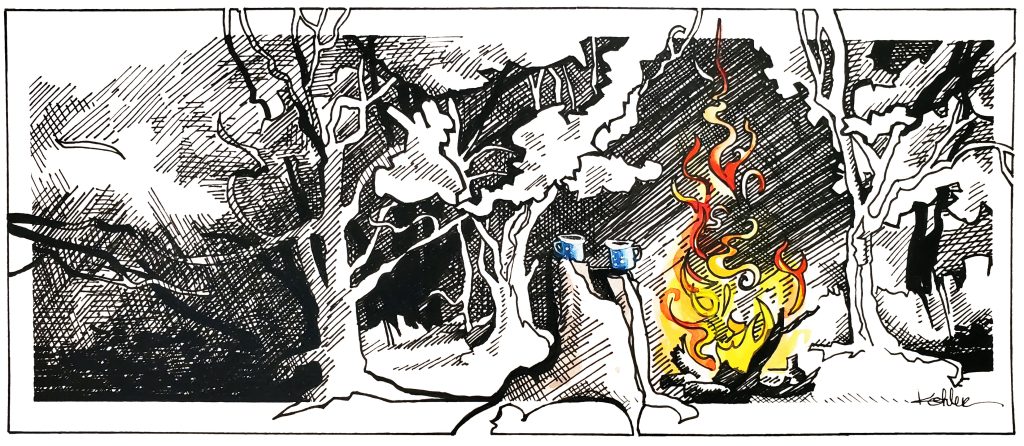
Coyote Campfire
Unlearning
My younger son is an amazing student and teacher, and I have learned a lot from his stories of what he’s gone through in various trainings. Recently he completed his training to become a helicopter flight instructor.
As a fascinated student and teacher myself I’ve loved the opportunity to ride his coattails with this, and hear stories about what he’s learning, and how they are teaching it. I’ve always been amazed and intimidated by the idea of being a Certified Flight Instructor – I mean, how much more real does it get, to take someone up and teach them to fly?! It was not lost on me that I would be risking my own life in the process of letting them take control. Lord knows, in my own flight training there were two significantly dicey moments when I endangered both of us in very real ways. But somehow we lived to tell the tale.
(As I read what I have written here, I have to laugh a little and admit that in its own way flight instructing is not so far removed from parenting, is it?)
So when Hyme called to talk about the “full down” training he’d just done near LA, I was delighted to be his debrief person. He can get so animated in the telling of the story that by the time the call was over, I was exhausted and exhilarated, feeling like I’d just done the training myself.
Full down training has to do with auto rotation. Auto rotation means managing your remaining lift to be able to bring the craft safely and more or less gently to the ground, in the case of losing power.
For simple piloting, the FAA considers it adequate to demonstrate your knowledge and ability to auto rotate to an altitude of 40 feet above the ground. But to be an instructor, you have to get an additional certification, called the “full down” certification. You actually do the full thing. You put the helicopter down on the ground.
As you might imagine, this can be a little hard on equipment, and a limited number of schools or instructors offer this certification. So Hyme had to travel to a new school to do this, and work with a new instructor.
He told me that he liked the guy immediately – he was one of those people who exudes solid competence, curiosity and an openness of being. So he was a bit miffed when this instructor said, as they climbed in to fly, opened with saying “Let’s talk about the two things you’re going to get wrong.”
“What?!” Hyme thought, “How do you know what I’m going to get wrong?!” It tweaked all his well earned confidence. He knows himself to be open to learning, willing to make mistakes….and he’s proud of that. So the part of him that knows himself to be a good student and quick study was affronted. What makes you so damn sure I’m not going to be the first one who gets it right right out of the chute?” It’s an honest question, actually, and the instructor heard him not say it.
He laughed and said, “I can see you don’t like that much. That’s OK, neither did I the first time. But here’s how I know that. You have 150 hours learning to do this thing a certain way. To apply left rudder in a certain circumstance. Your body knows to do that. It will do that. It’s muscle memory at this point.
What we’re doing here today is making a distinction, Yes in most cases, left rudder. Yes.
But in this case, it needs to be different. You need right rudder.
So your mind has to make the distinction, and your body has to unlearn so it can re-learn.
Nothing personal. You’ve just been wired, and wired yourself, to do something you now need to change. No harm, no foul, just is here to be done. Nothing personal.”
So here’s how it applies in my life – this story helped me to realize that my mind can learn new things pretty quickly, but my animal needs more time because it has to do more work, it has to unlearn something, so it can re-learn. Nothing personal.
It makes me think of habits and what I’ve been taught about habits. That they take time, a lot of people say 21 days, to change a habit. Another kind of random number, but it works for training.
But here’s the thing – that’s not always true.
As someone pointed out to me one time, if I have taken the same route to work every day for ten years, and you show me a way that is five minutes quicker, and takes me through beautiful country to boot, will it take me 21 days to go this new way? Probably not. Probably not. Chances are I’ll start going that way tomorrow.
Unless I don’t. I might forget…or I might resist remembering.
That’s been a huge question for me, on my journey: What the heck is up with all this resistance??
Why are there really good ideas that I resist running with, risks to have fun that I resist taking, fascinating and alluring paths I resist following? Why are there things I know I will love doing, once I begin, once I get a few miles down the road, but I back off from getting started, almost back out of the trip altogether? And if I force myself to keep going, why does it so often feel like slogging through tar?
I am so tired of resisting happiness. Resisting just being OK. All of a sudden I feel like I could cry with exhaustion. I’m so tired of it feeling so hard.
